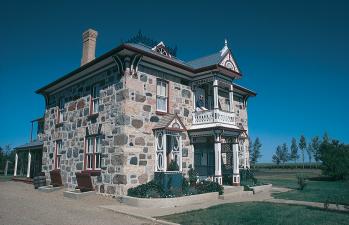
The Motherwell Homestead near Abernethy, property of W.R. Motherwell, was named Lanark Place after his Ontario home and modeled after the idealized farmstead of 19th-century Ontarian emigrants. The homestead manifested conventional wisdom on manipulating the prairie environment for beauty and efficiency.
The property, replacing an earlier homestead (1882), is divided by function and dominated by the two-storey, Italianate fieldstone house (1887) - itself divided, by Victorian conventions, into family, work, and public spaces (the Territorial Grain Growers Association was founded in the front room). It is surrounded by decorative landscaping, including flower gardens and a tennis lawn. The large, L-shaped red barn (1907), on the site of an earlier stone stable, is also of Ontario design. A dugout collected water while shelter belts gave protection from the elements, separated sections of the farm, and provided psychological security from the exposed prairie. This private microclimate was costly to maintain, requiring substantial support from Motherwell's political salary even as the farmstead proclaimed his social standing.
The farmstead fell into disrepair in the 1920s but was designated a National Historic Site in 1966 to commemorate scientific agriculture, western agrarian unrest, Ontarian settlement, and Motherwell's political career. Parks Canada undertook rehabilitation, replanting the shelterbelts and interpreting the site to the farm's heyday (1910-14).
Claire Campbell